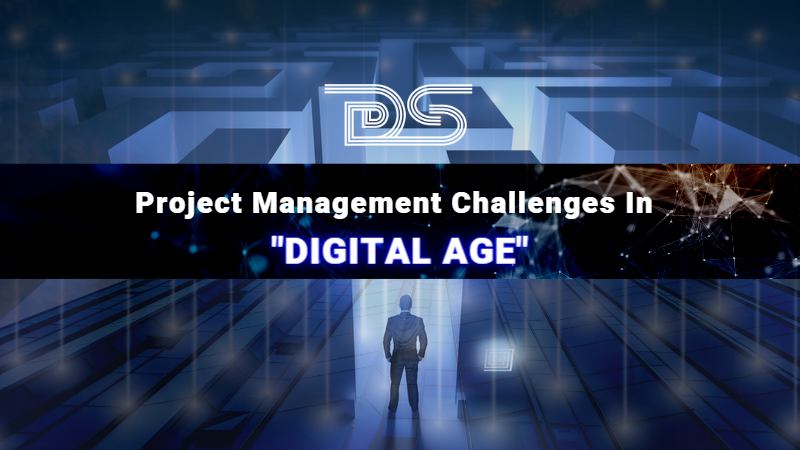
by DharamCW | Dec 18, 2022 | General
Artificial Intelligence, the most common and vibrant technical term in the 21st century, has begun to rule the world stage with its intelligent functionalities. There is no doubt that AI is transforming the productivity and workflow of various industries around the world. However, there may be a constant concern about human job opportunities in the coming years. Organizations have gradually realized that Artificial Intelligence requires collaboration with human employees, and ample job opportunities are emerging.
Impacts of Artificial Intelligence on Project Management
Project management has evolved significantly in the last decades. According to an IPMA & PwC report, 56% of organizations has already digital transformation projects, including AI adoption. The current adoption of AI among project professionals is expected to move from 27% to 35% in the next three years.
The organization must consider that successfully implementing projects in the digital age necessitates new skills and different focus areas for project managers. There is a growing demand for digital literacy, critical thinking, and creativity skills, replacing traditional project management skills such as teamwork, communication, and the ability to build effective relationships.

Benefits of AI in Project Management
Benefits of AI in Project Management
Aggregating task statuses to generate weekly status reports, calculating the budget implications of increasing scope and timeline, and performing risk modeling are all functions that an AI technique in your project management software can provide. Here are a few more advantages of AI-enhanced project management:
- Employees receive personalized coaching based on their learning habits.
- Increasing project success by releasing resources from routine operational tasks.
- Observe how a project is progressing and make educated predictions about its future.
- AI can keep track of budgets and schedules.
- Capability to manage complex analytics.
- With its unique ability to monitor patterns, AI is a capable project manager’s assistant.
Digital Skills for Project Managers
Businesses are creating better products and stronger customer relationships at an unprecedented rate. They rely on a workforce with the necessary skills and experience to deal with the effects of disruptive technologies. Organizations combine those experts with data and digital tools such as artificial intelligence and machine learning that allow for agility and speed.
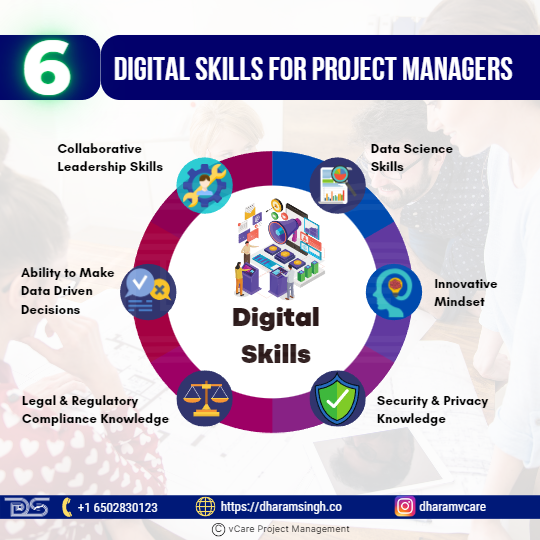
Digital Skills for Project Managers
Top Six digital-age skills for Project Delivery
1. Data Science Skills
Data science is the umbrella term for data management, analytics, and big data. It focuses on Project Managers’ ability to extract meaningful knowledge from available data to improve project outcomes. Data science is expected to play an increasingly important role in all stages of project development, from planning to completion.
2. Innovative Mindset
Today’s project teams are being asked to do more with less. That means that Project Managers who can think creatively and find new ways to achieve great results will be in high demand in the job market. Skills and experience are no longer sufficient. It is now critical to provide examples of one innovative mindset in the workplace.
3. Security and Privacy Knowledge
Today, most businesses and individuals are concerned about data security. In addition to the legal requirements, there is a general expectation that all personal and project data is handled securely. This skill is becoming increasingly important as more projects rely on digital information systems.
The best Project Managers contribute to the security of the projects they manage. They are aware of the requirements and collaborate closely with their IT and legal teams to ensure that data security guidelines are incorporated into each step of project delivery.
4. Legal and Regulatory Compliance Knowledge
Ensuring the project is legal and regulatory compliant is not new. Leading Project Managers are always aware of this. The difference that the digital age brings is the growing need to act as a bridge between project teams and the IT, Legal, and Data Protection teams, all of which are critical to the process but need little understanding of each other’s areas of expertise.
5. Ability to Make Data Driven Decisions
Using data to make sound business decisions is core to the best practice of project management. Today’s challenge is synthesizing the massive amount of data available to gain useful insights that propel a project forward. Data is only useful if it is appropriately interpreted. The best project managers use cutting-edge tools to make informed decisions and gain an advantage.
6. Collaborative Leadership Skills
Because of remote working, outsourcing, and cross-functional teams spread across multiple locations, Project Managers today require collaborative solid leadership skills more than ever. Their ability to establish standards and bring team members together (even if only virtually) for the sake of the project is becoming increasingly important. Project managers who can implement collaborative platforms and work management tools to improve their team’s work will outperform their competitors.
An Emotionally Intelligent Project Manager
Emotional intelligence can be referred to as our ability to recognize, control, and communicate emotions. People with high emotional intelligence understand how they feel, what their feelings imply, and how their feelings affect others. In interpersonal situations, it is also the ability to empathize with others. Emotional intelligence is about creating a positive work environment, which is critical to the success of any project.
According to a LiquidPlanner study, most project managers commit approximately 10% of their time to people-related activities. Top project managers dedicate 70% of their time to these activities. As a result, emotional intelligence is critical to project success.
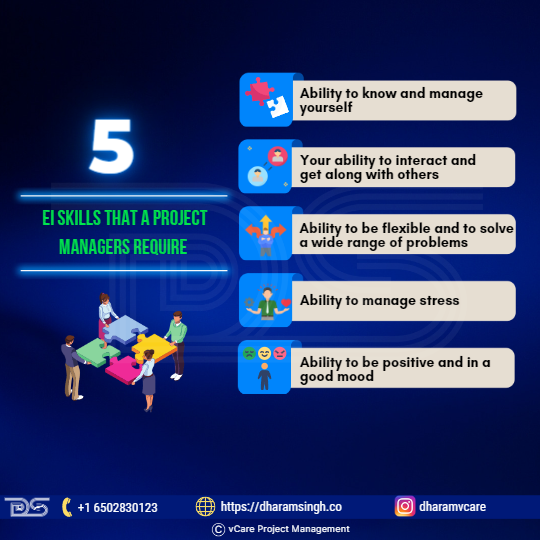
EI skills that a Project Managers require
Some EI skills that project managers require are:
- Intra – Personal – Ability to know and manage yourself
- Inter–Personal – Your ability to interact and get along with others
- Adaptability – Ability to be flexible and to solve a wide range of problems
- Stress Management – – Ability to manage stress
- General Mood – Ability to be positive and in a good mood
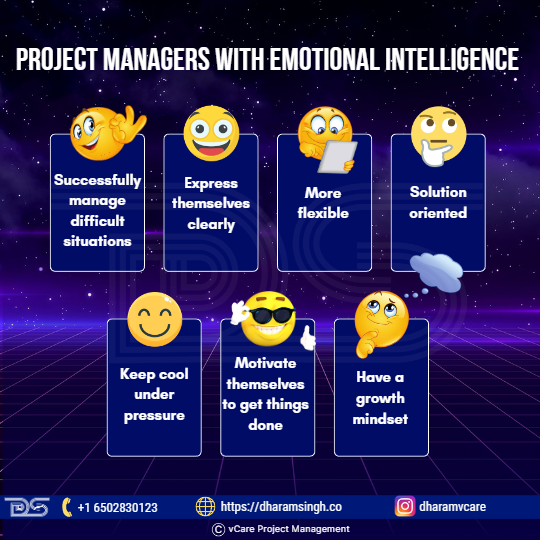
Project Managers with Emotional Intelligence
Emotionally Intelligent Project Managers
Project managers with high emotional intelligence have a better chance of success, better physical and mental health, good work relationships, and lower stress levels. Project managers with emotional intelligence can also:
- Successfully manage difficult situations
- Express themselves clearly
- More flexible
- Solution-oriented
- Keep cool under pressure
- Motivate themselves to get things done
- Have a growth mindset
Project Leadership in “DIGITAL AGE”
Over the last decade, the project management practice has evolved from a simple guide for project managers to a deeper understanding of organizational maturity and business agility. However, to capture the true essence of organizational maturity and business agility, the project management practice needed to evolve again, this time by adapting to the needs of the digital world.
According to a PMI’s report, The Project Manager of the Future, which surveyed over 450 HR professionals, over three-quarters of these organizations recognized the importance of project managers understanding disruptive technologies. They were actively recruiting project professionals with specialized skill sets required to manage the impact of disruptive technologies. But what are these skill sets?
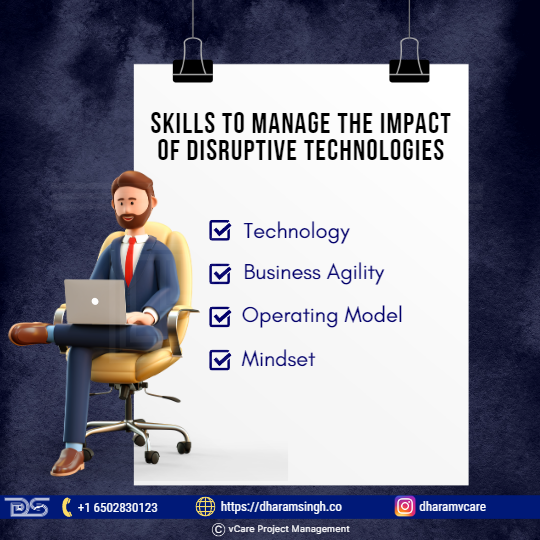
Skills to manage the impact of disruptive technologies
- Technology
- Mindset
- Operating Model
- Business Agility
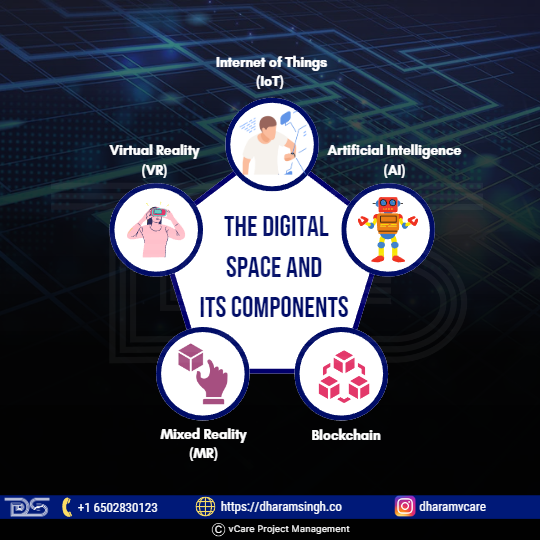
The Digital Space and its Components
Beyond using digital transformation as a token, project managers must gain a thorough understanding of the digital space and its various components, such as the Internet of Things (IoT), Artificial Intelligence (AI), Blockchain, Virtual Reality (VR), and Mixed Reality (MR).
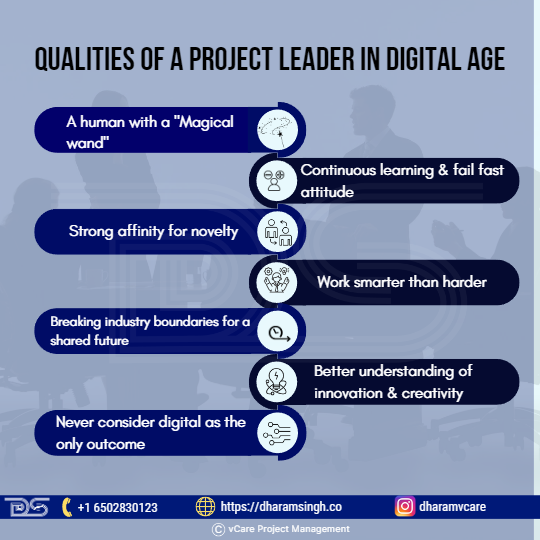
Qualities of a Project Leader in Digital Age
Along with that, the project leader must have these qualities in the digital age:
- A human with a “Magical wand”
- Continuous learning & fail fast attitude
- Strong affinity for novelty
- Work smarter than harder
- Breaking industry boundaries for a shared future
- Better Understanding of Innovation & Creativity
- Never consider digital as the only outcome
Digital transformation in project management is more of a collective mindset than a task that can be checked off as completed. It describes a vision that needs constant improvement and encourages future innovation and growth.

3C’s need to be followed by project leadership in the digital age
Here are the 3C’s need to be followed by project leadership in the digital age:
- Calm – Inspire more trust and better performance.
- Connect – People will forget what you said, People will forget what you did, and People will never forget how you made them feel that moment.
- Communicate – The biggest problem in communication is the illusion that it has occurred.
Challenges faced by Project leadership Teams
1. Disconnected & disengaged remote workforce
HR leaders and project managers nowadays, regardless of industry or size of business, assume that connecting with people within the organization is becoming increasingly difficult. Remote working, prompted by the pandemic, has only exacerbated the situation. But why is having a connected workforce important?
A well-connected workforce means employees and the company’s vision, mission, and values are connected. Employees who might feel isolated and disconnected from the business and its goals and objectives, regardless of where they work, are likely to feel disengaged and demotivated, which may affect productivity and efficiency at work. Here are some ideas for how businesses can manage disengagement and create a more connected workforce.
- Use technology to stay connected
- Recognize the good work
- Implement Open Culture
2. Uncertainty in decision making
Project managers strive to conform to all elements and avoid uncertainty in project management to ensure the success of their endeavor. However, no one can predict the future. Working on large, complex projects, such as those in technology, frequently entails high uncertainty in terms of time, cost, and scope, as well as uncontrollable external forces such as inflation, regulation, and financing constraints. These factors can impact a project management system’s ability to assist managers in leading and monitoring projects. Therefore, the project management must comprehend the process of applying decision analysis techniques to the practice of project management, like:
- A process that can assist project managers in improving their ability to make decisions under uncertain conditions.
- A process that can assist project managers in confronting
- Resolving the realities of the project management—uncertainty, external influences, and risk.
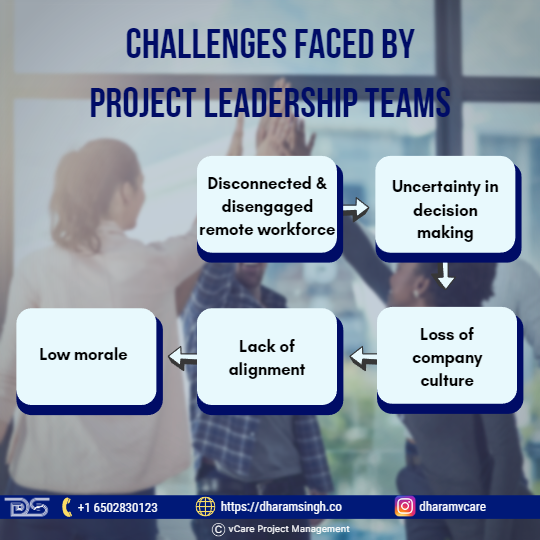
Challenges faced by Project Leadership Teams
3. Loss of company culture
Employee attitudes, values, beliefs, behaviors, and underlying assumptions comprise organizational culture. Furthermore, culture is important because it forms the foundation of the business logic applied to any specific decision or problem; there is a minimal chance that something will be done that violates the culture because it would mean contradicting fundamental beliefs.
An organization’s culture, which is not supportive of project management, may be perceived as an additional burden and an impediment to daily work.
4. Lack of alignment
Project success begins with good project management practices and a good team. But how do you make sure they’re in sync? Especially when alignment requirements can take many forms, such as alignment to the overall strategy, stakeholder expectations, mandated processes or policy, or delivering the right things at the right time and in the right way.
Moreover, business organizations may require precise alignment of project strategy to prevent projects from duplicating work or producing useless deliverables to reduce waste and manage costs. Strategic thinking is one way to foster the game-changing power of aligned organizational strategy to project outcomes.
5. Low morale
Employee morale is employees’ attitude, contentment, loyalty, and willingness to give their all and actively contribute to their employer’s success. It’s also about how they feel about their job and workplace.
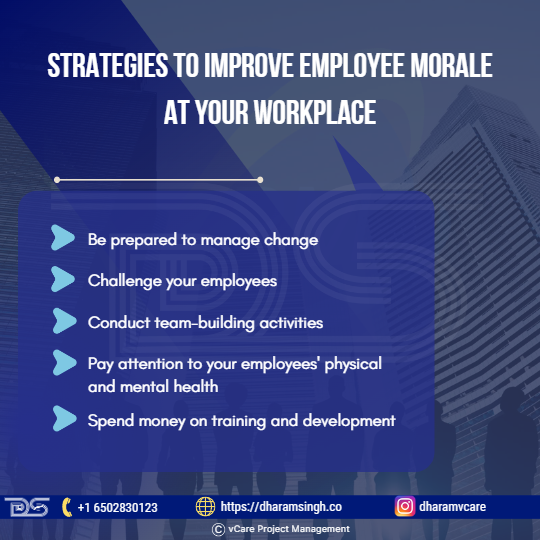
Strategies to improve Employee Morale at your workplace
If the employee morale is low, it may reduce motivation and efficiency. Employees with low morale produce only the bare minimum of work. As a capable leader, improving workplace morale should be one of your top priorities. According to an SHRM survey, 67 percent of employers find it challenging to maintain employee morale. However, the good news is that the following strategies can help immediately improve employee morale at your workplace.
- Be prepared to manage change
- Challenge your employees
- Conduct team-building activities
- Pay attention to your employees’ physical and mental health
- Spend money on training and development
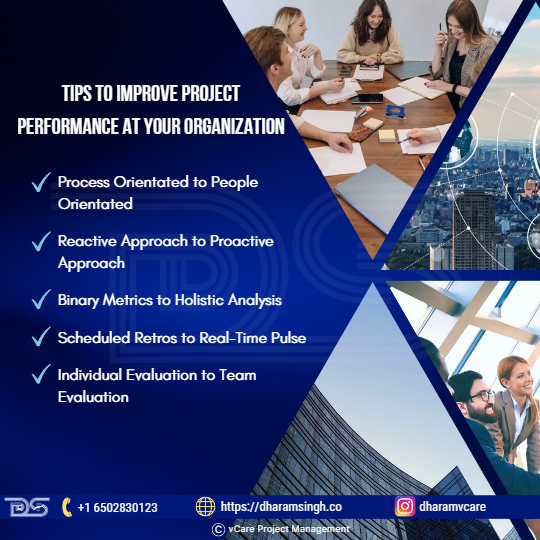
Tips to improve project performance at your organization
Revamp Project Team Performance
A combination of managerial skills and software tools are used to improve project performance. Ensure that the team understands the goal of every project, has access to open communication channels, and understands the importance of tasks. In addition, project management software can create consistent project plans and automate time tracking and billing to improve project performance. Here are some tips to improve project performance at your organization.
- Process Orientated to People Orientated
- Reactive Approach to Proactive Approach
- Binary Metrics to Holistic Analysis
- Scheduled Retros to Real-Time Pulse
- Individual Evaluation to Team Evaluation
The Five Dysfunctions of a Team
Patrick Lencioni, the author of “The Five Dysfunctions of a Team” examines why effective teams are so rare and offer specific recommendations for removing barriers that lead to dysfunctional teams. The work of Lencioni outlines the causes of team dysfunction and what can be done to overcome each one.
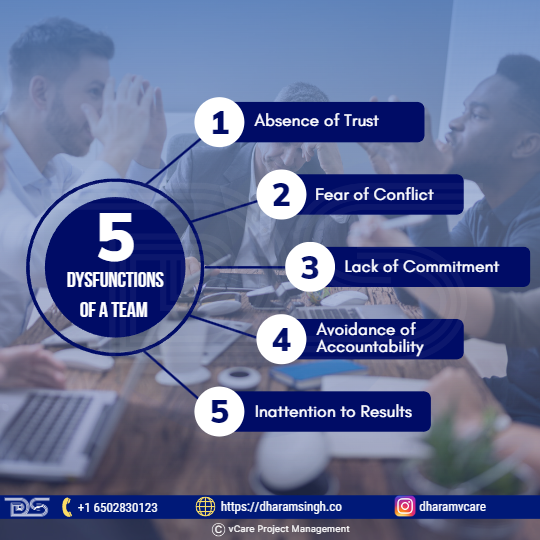
5 Dysfunctions of a Team
The five dysfunctions which have been compared with project management are:
- Absence of Trust – Teams that lack trust conceals flaws and mistakes, are hesitant to seek assistance, make assumptions about the intentions of others, harbor grudges, and dread meetings.
- Fear of Conflict – Fear of conflict results from a lack of trust. Most companies’ employees are more concerned with politics and personal risk management than problem-solving. As a result, meetings are frequently boring because contentious issues are avoided.
- Lack of Commitment – When teams avoid conflict, they fear failure. These teams struggle to make decisions and constantly second-guess themselves.
- Avoidance of Accountability – Second-guessing and a lack of common objectives lead to an inability to develop performance standards. Team members miss deadlines and produce mediocre results.
- Inattention to results – When teams lack focus and clear objectives, team members become stagnant, distracted, and self-centered.
High-performance teams
High-performance work teams are critical to how most organizations perform and carry out their work, resulting in superior performance and a significant competitive advantage. A high-performance team also requires the following to function effectively:
- Uplift the quality of work.
- Mentor guidance to increase productivity.
- Peer-to-Peer monitoring & building a competitive environment.
- Facilitating & enriching the team to handle emerging project delivery practices.
Nurturing the Right Culture
Building an organization’s strong project management culture opens the door to numerous benefits and improves customer service. Organizations with solid project cultures operate under a unique value system that aligns each team member with objectives and goals on a budget, time, and target. Professionals today are expected to demonstrate a wide range of skills and juggle multiple organizational tasks.
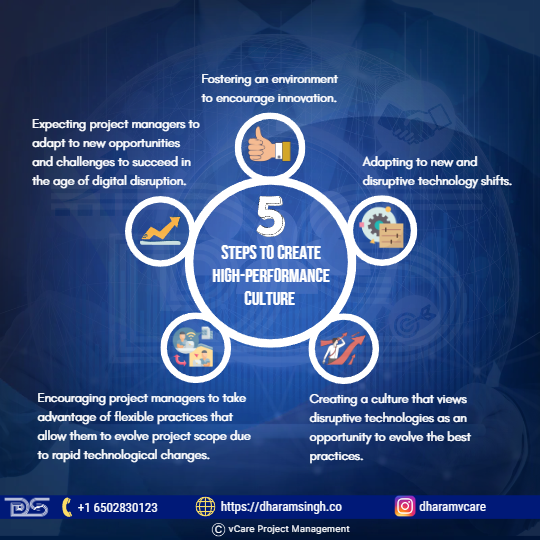
Steps to create High-Performance Culture
5 Steps Involved in Creating High-Performance Culture
- Fostering an environment to encourage innovation.
- Adapting to new and disruptive technology shifts.
- Creating a culture that views disruptive technologies as an opportunity to evolve the best practices.
- Encouraging project managers to take advantage of flexible practices that allow them to evolve project scope/requirements due to rapid technological changes.
- Expecting project managers to adapt to new opportunities and challenges to succeed in the age of digital disruption.
Conclusion
To capitalize on all opportunities created by technological disruption, the most forward-thinking organizations rely on the power of project leaders. One significant competitive advantage is where project leaders are prepared, willing, and able to assist their organizations in surviving and truly thriving in the face of massive change.
However, innovative organizations recognize that project leaders with the necessary digital-era skill sets do not appear by chance. As a result, innovators understand the importance of investing in three key areas:
- Skills, training, and development
- Tools and approaches
- Culture
Feel free to check out my discussion on this topic with Thomas Walenta in YouTube
You can subscribe and follow my podcasts and interviews with Project Management Experts on YouTube at https://bit.ly/2NDY8wd
You can subscribe to vCare Project Management YouTube Channel to catch future videos of our certification Q&A series and student success stories using the link https://bit.ly/2YF0wJl
For any questions related to Project Management career, training, and certifications, you can book an obligation free 15 minutes session with me by visiting talktodharam.com
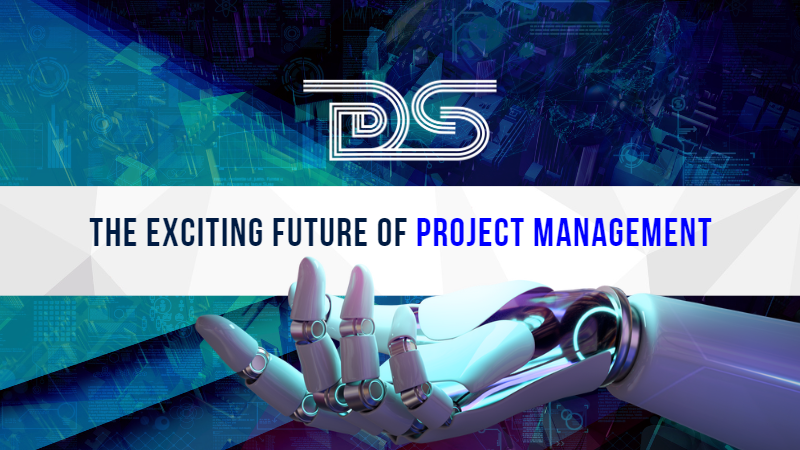
by DharamCW | Nov 28, 2022 | General
Project management “is the application of tools, knowledge, processes, and competencies to ensure the successful completion of a project.” Projects are time-bound endeavors that seek to generate value through products, services, or outcomes that meet the project’s objectives and success parameters.
Project Management Institute (PMI) defines project management as “the use of specific knowledge, skills, tools, and techniques to deliver something of value to people.”
Project management is leading a team’s work to achieve all project goals within the constraints set. The primary rules are scope, time, and budget. The secondary task is to optimize the allocation of required inputs and apply them to achieve predefined goals.
Project managers are essential to a project’s success and are in high demand. They employ various skills and knowledge to engage and motivate others to achieve the project’s objectives. By 2027, employers will need 87.7 million individuals in project management-oriented roles as per the “Job Growth & Talent Gap 2017-2027” report.
“The Future of Project Management By Harold Kerzner, Ph.D., and J. LeRoy Ward International Institute for Learning (IIL)” article discusses four new principles to determine what types of project management training we believe are available to project managers in most of today’s successful business models.

Four Principles of Project Management Training
- First and most importantly, project management is now viewed as a business process in which project managers are expected to make business and project-related decisions.
- Second, project management is no longer viewed as a collection of operational or tactical activities to produce a deliverable or outcome.
- Third, project management is now a delivery system for achieving the desired business benefits and value.
- Fourth, project management is no longer just another career option within a company.
As more and more digitization is growing, project management has never been as exciting as it is now. The overall trend is an increase in the need for project managers. Project management is no more a job that deals with Gantt charts and ticking off a checklist.
Project management has always been a great profession to be in. It allows one to work with people, deal with risks and conflicts, and the ability to manage the outcomes for the business. It always gives you a feeling of importance and provides the opportunity to take leadership to drive the business goals. It greatly enhances your soft skills and helps you work with people to improve their capabilities along the project.
Apart from this, a project management profession helps you develop yourself and constantly provides new challenges every day. As the business grows dynamically, newer challenges and opportunities are managed by the project managers of today’s times. It provides career progression in terms of becoming a project manager, program manager, portfolio manager, and so on.
Project Management Trends
The project management industry rapidly evolves with the latest trends, tools, and technologies as the changes in trends in project management are dynamic and unavoidable. Therefore, understanding current project management trends will help us stay on top of the profession or business.
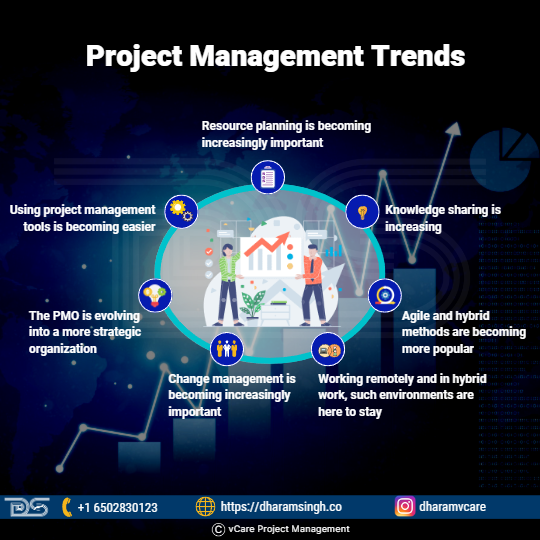
Project Management Trends
Trend 1: Resource planning is becoming increasingly important.
Trend 2: Knowledge sharing is increasing.
Trend 3: Agile and hybrid methods are becoming more popular.
Trend 4: Working remotely and in hybrid work, such environments are here to stay.
Trend 5: Change management is becoming increasingly important.
Trend 6: The PMO is evolving into a more strategic organization.
Trend 7: Using project management tools is becoming easier.
In a post-pandemic world, employing top project managers is more important than ever. Remote working, upskilling, and the pandemic’s lingering effects will shape the future of project management.
Increasing Emphasis on Soft Skills
Traditionally, the value of project managers was determined by their certifications and ability to implement various methodologies. However, many organizations are shifting their emphasis to soft skills. This project management trend is understandable, as AI-powered solutions have advanced to the point where they can handle the more challenging technical aspects of project management.
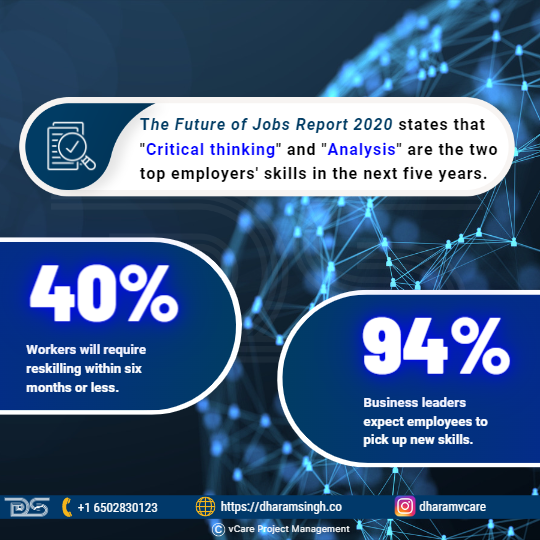
The Future of Jobs Report 2020
The Future of Jobs Report 2020 states that “Critical thinking” and “Analysis” are the two top employers’ skills in the next five years. 40% of workers will require reskilling within six months or less. 94% of business leaders expect employees to pick up new skills.
Project managers must now focus on improving their soft skills in conflict resolution, stakeholder engagement, negotiation, mentoring and training, decision-making, and team building. Practicing these skills will enable project managers to add more value to their organization.
Predictions for the Future of Project Management
“Change is the only constant,” as the adage goes. Project teams are no longer smaller, and the projects are no longer more straightforward. It appears to be true in the project management industry. The project management landscape is rapidly changing with evolving technologies, tools, and the latest trends.
Unlike the olden days now, there are a lot of tools, techniques, and methods that project managers can adopt to make the job much easier and more effective. Three major factors that would impact are:
- The Dynamically changing technology landscape.
- Increasing organizational complexity with Remote & Hybrid Work.
- Sustainability/Ecological concerns.

Factors Impacting Future of Project Management
1. The Dynamically changing Technology landscape
We will look at how the future of project management is evolving and exciting as the future holds concerning some of the changing technology components which are emerging.
a.) The growth of Artificial Intelligence (AI) and Automation
According to the Project Management Institute, 81 percent of professionals believe that AI impacts their organizations. Project managers are given a chance to focus their efforts and energy on tasks that will most significantly benefit their businesses. Automation can help project managers to effect more significant change and increase the chances of each project achieving its strategic goals.
By 2030, AI will have taken over 80 percent of the work of today’s PM discipline, including data collection, tracking, and reporting (Gartner, 2019).
PMI’s Pulse of the Profession report emphasizes the importance of data science skills, an innovative mindset, security and privacy knowledge, legal and regulatory compliance knowledge, the ability to make data-driven decisions, and collaborative leadership skills.
According to PwC’s ’22nd Annual Global CEO Survey, in the next five years, 85 percent of CEOs believe AI will significantly change how they do business. Even though it is still in its early stages of development, AI can be used in project management to reduce highly complex issues and play a significant role in their success.
In recent years, organizations have adopted AI on a larger scale to ensure successful project completion in a variety of ways, including:
- Producing performance insights
- Assisting in decision-making processes
- Estimating and forecasting
- Optimizing resource allocation
- Making data visualization possible
- Conducting risk analysis
AI with chatbots can even be integrated for project management reports and status on tasks. Also, the status can be updated from anywhere and anytime. It can help as an intelligent project assistant. Already products like PPM Express are working in this space. In construction and engineering space, AI can be used for monitoring sites and site inspection with the help of OpenCV, Drone cameras, etc. Large enterprises are using AI for intelligent resource deployments for projects.
b.) Rise in Data Analytics Focus for Data-Driven Project Management
Every day, organizations of all sizes generate massive amounts of data as it is only logical to use that data to notify decisions. Data analytics and reporting can assist project managers in identifying early signs of scope creep, calculating project progress rates, and other tasks.
AI-powered analytics provide a comprehensive picture of the entire organization and all projects. They provide granular visibility into activities and generate custom reports to assist project managers in visualizing data as required. With these tools, project managers can make informed decisions in real time rather than making gut-based decisions based on manually compiled reports.
c.) Advanced Project and Resource Management Tools
According to a 2020 report from Wellingtone, 54 percent of organizations lack access to real-time KPIs for their projects, and more than a third spend more than a day collecting data. This result demonstrates that project management tools can no longer be overlooked. When combined with AI-based automation capabilities, project management software can positively change how organizations manage their projects, regardless of their complexity.
Project managers of the future cannot survive without digital skills. The learning and experience on these tools will help appropriately present data and enhance decision-making with stakeholders. Current project management tools have become digital. Collaboration is seamless. For making effective decision making, the project managers need to have a good hold on the areas like the following:
- Data analysis, analytics, and management
- Security and data protection
- Legal and regulatory compliance
- Online collaboration and leadership (JIRA, Confluence, etc.,)
- Knowledge management (Sharepoint, Google Docs, etc., )
- Data-driven decision making. (BI Tools – Power BI, Tableau, etc.,)
Here are some examples of how the appropriate software can make a significant difference in future project management:
- Use historical project data to improve bids and plans for future projects.
- View resource availability, skills, and other details to make resource allocation easier.
- AI can automatically track all time spent on tasks and projects.
- To stay on top of finances, quickly allocate and track budgets.
- In real-time, capture all expenses with invoices for all projects.
- Track all projects using customizable dashboards to make better quick decisions.
- Maintain real-time communication with all stakeholders and team members about the project’s status, progress, and changes.
d.) Internet of Things:
The Internet of things is a network of electronic sensors and actuators that can help interact with each other and exchange data for numerical applications. We already see its application in the form of Alexa, Digital watches, Smart Vending Machines, and many more. The Internet of things can provide useful real-time data and help in various ways in project management. Assuming you are working on a team or sensitive project with technical and regulatory characteristics that need real-time data with a higher speed of reporting. IoT can help improve process control and also manage the explosion of valuable data on the project from sensors and devices. Project Managers can use these IoT technologies to reduce the workload in collecting data and streamline the reporting efforts.
e.) Digital Twins:
The Internet of things has been evolving, and it has been contributing to a lot of industries in terms of monitoring, real-time analytics, etc.; Projects involving Infrastructure, Construction, and industries would need a lot of physical presence. Digital twins can work with CAD and BIM (Building Information Modeling) data sets. Projects executed on these domains also call for ensuring the safety of the stakeholders involved in the project. In such scenarios, a digital twin can provide digital replicas of the physical objects or the location, which can encompass the project’s design and engineering aspects, which should help minimize travel/physical presence at the engineering sites. This action would also greatly enhance the better visibility of the sites in digital means for faster and more responsive actions on the project, yet contributing to sustainability via fewer carbon footprints. Digital twins provide intuitive visuals of the project situation with context and help to make decisions faster.
2. Increasing organization complexity with Remote & Hybrid Work
Remote working was already popular, but it has skyrocketed to unprecedented levels in recent years. While the global pandemic forced organizations to allow employees to telecommute due to safety concerns, remote work tends to continue for the foreseeable future. This aspect presents some intriguing challenges to project managers. According to Forbes, up to 97 percent of employees are unwilling to return to their offices full-time.
There have been renewed efforts in the post-pandemic era that many organizations have begun to experiment with a hybrid approach that combines elements from two or more methodologies. It is no longer just about agile, scrum, or lean but about combining specific attributes for increased flexibility in driving project success. This approach has enabled organizations to develop distinctive approaches to particular industries and projects.
The hybrid concept extends to the development of project team structures. The Capterra report states that 37% of teams are cross-functional and led by a dedicated PM. Cross-functional teams can share their department’s best practices for the project team to decide whether they want to incorporate them into their processes.
Hybrid project management is evolving. Projects are complex with a mix of technology, domain, people, process, and tools. Many organizations are not even ready for such a change to adapt themselves. Based on recent research by IPMA(International Project Management Association), only 47% of organizations are using agile approaches. Situations like the COVID-19 Ukraine-Russia conflict are making the environment more uncertain. Geopolitical situations can put countries and global projects at risk, increasing the challenges for project managers to be dynamic and responsive.
The project managers have to address problems like the following, which could be exciting and challenging:
a) More collaboration with contractors and suppliers
b) Higher staff turnover
c) Stakeholders having competing demands and expectations
d) Need for decisions taken faster
e) Increasing complexity in regulations and governance
Due to the inherent nature of dynamic technological changes, there is a need to manage constant training/coaching for the project members involved. This context keeps the project manager and project executives current and on the learning curve. In the future, project managers will be successful if they break the typical corporate mindset. They will be the ones who work with a hybrid approach and mindset. The term “hybrid” refers to the ability of the Project Manager to take an adaptive approach to the multiple roles and provide value with cross-functional/diverse teams.
Though technology plays a central role in project management, the project managers are expected to have great levels of emotional intelligence to manage the project members. The Project Manager needs to maneuver through social skills and empathy. This move would greatly contribute to the productivity and quality of the projects.
3. Sustainability / Ecological concerns
Project managers have to become socially responsible in alignment with the organizational culture, structure, and processes, starting with environmental analysis as per the PMBOK Guide. It would be exciting for the project managers to contribute to sustainability by adding the sustainability objectives to the project charter apart from the financial business case. This action might call for additional training on aspects like sustainability LCA(Life Cycle Assessments).
From sourcing to day-to-day operations in the project, the project manager needs to consider minimizing the carbon footprint, and it’s no more a thing specific to governments. Sustainability involves balancing different concerns:
- Environment, such as climate change
- Society, such as community
- Economy, such as affordability
- Administration, such as health and safety
When these four elements are considered, we can build sustainability into projects. (Reference: APM Body of knowledge 7th Edition)
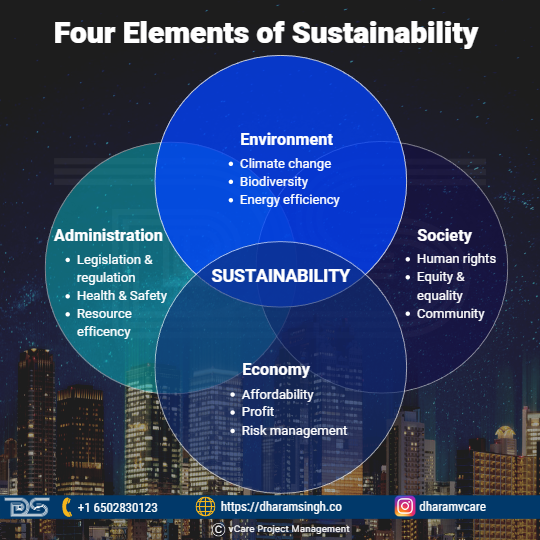
Four Elements of Sustainability
Project managers need comprehensive risk management when it also calls for transparent project communication. Especially when it comes to a project with a high level of material handling, sustainability aspects in terms of procurement from the right suppliers, verification of the sources, material origin, quality of the material, etc., would come into context. Project managers must look from all the above perspectives to make sustainable project management a reality.
Conclusion
The project management profession has come into an exciting phase as it’s more challenging and has more tools to make it easier. Only with an appropriate level of training on the tools and adoption of emerging trends would project managers be able to sustain it. The project managers’ skills move in the direction of having focus, multi-skill leadership, emotional intelligence, change management, and negotiation skills. Achieving certifications would be to have an aspect to prove your credentials and have a structured approach to your thought process complementing your experience and skills in these areas outlined in this article.
Understanding current project management trends and predicting the future of project management is critical for staying on top of the profession. Considering the predictions, the future looks bright for those who can adapt to changing trends by expanding their knowledge of new tools and techniques and pursuing accreditation for project management in their specific industries.
Feel free to check out my discussion on this topic with Thomas Walenta in YouTube
You can subscribe and follow my podcasts and interviews with Project Management Experts on YouTube at https://bit.ly/2NDY8wd
You can subscribe to vCare Project Management YouTube Channel to catch future videos of our certification Q&A series and student success stories using the link https://bit.ly/2YF0wJl
For any questions related to Project Management career, training, and certifications, you can book an obligation free 15 minutes session with me by visiting talktodharam.com

by DharamCW | Oct 10, 2022 | General
A Project Management Office (PMO) is a group or department within an organization that defines and maintains project management standards. It provides project management guidelines and standards. In addition, it aids in developing measurable objectives that align with the organization’s overall vision and ensure that all targets are met. PMO will also be referred to as a program or project portfolio management office, depending on the project/program/portfolio.
The Project/Program/Portfolio office has undergone a paradigm shift during this COVID-19. This shift has also paved the way for innovative ways of its operations and leads us to the question of revisiting gaps PMOs have from the context between where we are today and how the future holds for the PMO. Project managers/portfolio managers need to embrace today’s PMO situation and be ready for transformation in the days ahead. There could be challenges and opportunities that need prioritizing. This article helps to envisage the gaps between PMOs of today and PMOs of the future.
PMO Types
PMOs are based on their degree of control and influence on projects. Of the many types, there are three distinct types of PMO.
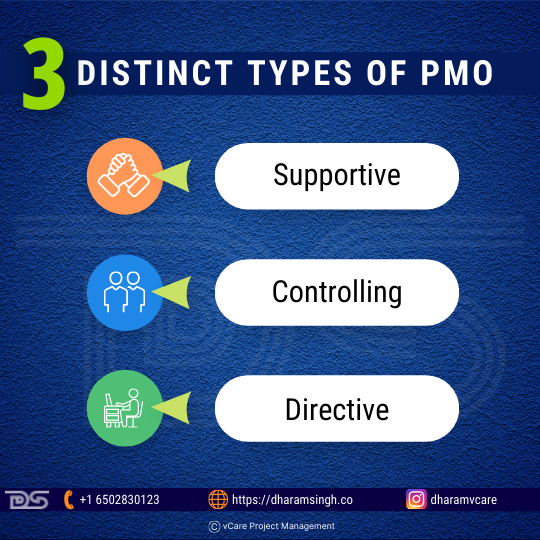
3 Distinct Types of PMO
- Supportive: A supportive PMO gathers all of an organization’s projects and provides best practices, templates, and training but with limited control.
- Controlling: A controlling PMO ensures that project management tools, processes, and standards are implemented in a controlled manner.
- Directive: Within the organization, a directive PMO maintains a high level of control over the project management process.
In 2020 according to the Wellingtone Survey, 89% of organizations reported having at least one PMO.
Role of PMO
Project Office was the term used for aircraft development in the 1930s by the U.S. Air Corps. PMO has been widely adopted since the 1980s when it was first adopted in Construction and IT and slowly adopted in other sectors. It added value and efficiency to the projects and programs through better management. PMO was considered a central administrative office responsible for setting up standard project management methodologies, processes, guidelines, and templates for project teams.
Besides that, PMO extended the arms in training the teams involved in a project about project management practices. Essentially, they imparted knowledge on appropriate project management practices, which helped team members be on the same page on project management practices. They maintained and tracked the lessons learned risks, and project progress, integrated the data between projects, helped share common resources across projects, and ensured project alignment to the business’s strategic objectives. They have been acting more like a center of excellence for Project Management.
Steps to be taken when developing a PMO strategy
- Clarify your company’s goals, vision, and mission.
- Take note of the resources required for a successful operation.
- Choose the best mode of communication.
- Create a system for tracking progress.
- Create a process for resolving conflicts and overcoming project bottlenecks.
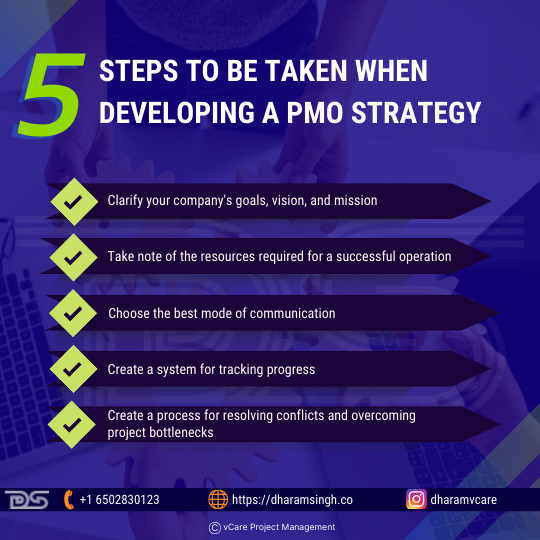
Steps to be taken when developing a PMO strategy
Situation today
In the White Paper: The Future of PMO by Aled Laugharne, Chaucer, states that:
- PMOs operating in the “traditional” way continue to meet stakeholder expectations in around 80% of cases and are considered critical to the program’s success.
- Governance, reporting, planning, and exceptions are all areas where PMOs excel.
- At present, achieving Level 2 – Foundational is sufficient to meet key stakeholder expectations. However, moving to Level 3 – Advanced increases the likelihood of PMOs being marked as “exceeding.”
- Although employers entirely staff some PMOs, consultants and contractors continue to play an important role in PMOs.
- The wider program community is typically less satisfied with PMO performance than key stakeholders who sit centrally.
- In general, there is a 50:50 split between PMOs that believe they need to prioritize improvement and those that want to maintain the status quo or have other program priorities.
Current Potential positive and negative impacts of PMO
The Covid-19 pandemic was the primary driver under External Impacts. However, the consequences of the current crisis appear destined to shape the future of PMO. The following are examples of potential positive and negative consequences:
- Cost-cutting in pandemic-affected industries has resulted in a shift in PMO resourcing to internal staff.
- Change and transformation occur due to the pandemic’s response, increasing the demand for PMO, such as in the Life Sciences industry.
- As a result of virtual working, the need for online collaboration tooling for PMOs is growing.
- With co-location in the country no longer required, virtual working increases global competition for PMO services.
- The rise of Agile PMOs is designed to respond quickly to changing external conditions.
Organizations have started looking to PMOs to optimize the management of increased projects. PMO is responsible for managing delays, cost overruns, quality, and style of the project management practices. Also, they have been involved in resource utilization and accountable for cost-overruns in the projects. It is no more just an administration or supportive role but has become pivotal in strategic and tactical operations across projects.
Today’s PMO in large organizations has an influential role to play. More than being supportive, it has become directive and controlling for compliance and alignment towards organizational objectives. In some organizations, PMOs operate at Strategic Business Unit level or Vertical in alignment with specific sectors with a key focus on Planning, Support, Monitoring, and control functions.
PMO office is involved in providing consistent templates, resources, and tools consistent across projects. Provides an integrated project management capability across the projects and facilitates collaboration in cross-department aspects to align and meet strategic business goals. The tools used and recommended by the PMO are based on Technology, Ease of adoption, price benefit, and ability to scale. Their results directly reflect upon the organization’s operational and resource challenges. Today’s PMO organization helps in who will use the tool, which will maximize benefit, impact on the PMO process, how readiness in terms of adoption, etc.,
Not to mention the problems of meeting deadlines, cost, scope, and quality. There are other areas where PMOs have to evolve; we will discuss some challenges faced by today’s PMOs.
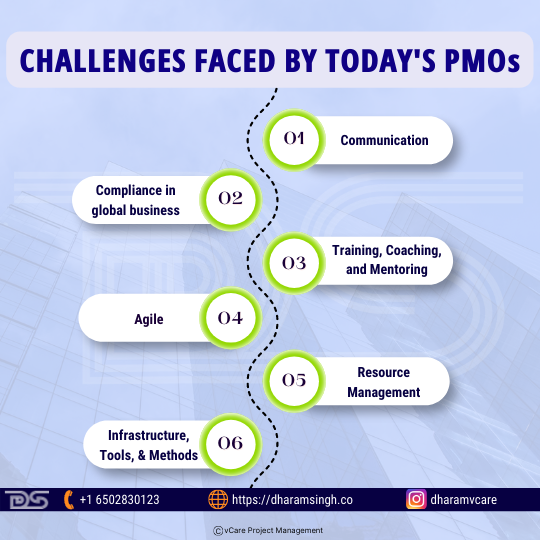
Challenges faced by today’s PMOs
Communication: As an organization has become more digital, the information required by different stakeholders and different levels requires varied contexts. Communication gaps still affect the sponsors or stakeholders due to the availability of information to act on time with the right context. As businesses are so quick to change and environment is dynamic, and priorities change frequently, the PMO must align and adapt quickly.
Compliance in global business: Organizations are no more local. Small or big organizations are starting to have global access thanks to digital. Compliance with organization standards or government regulations when operated across multiple countries. Non-Compliance could turn out to be very costly. Varied and fast changes in procedures/processes would be an additional burden in implementation. Also, cultural factors/time zones would matter when the PMO office is central and not decentralized.
Training, Coaching, and Mentoring: PMOs have to do different things apart from typical training methodologies with project managers/portfolio managers and project associates. When the domain changes, Project managers struggle to cope with these situations. PMO has to help the project manager with an appropriate strategy of training. Ability to track with leading indicators of the training rather than measuring the lagging metrics.
Agile: Large enterprises and organizations are already adopting agile. Requirements are evolving, and project managers don’t have the luxury of having absolute clarity. Yet PMO needs to help the project teams to bring clarity amidst ambiguity, managing assumptions, the definition of done, prioritization, etc. The problem-solving methods have to be made simple and deliver faster decision-making.
Resource Management: Minimizing resource waste is a key function for PMOs, and nowadays, organizations have sustainability goals that will naturally transpire to the PMOs along with project goals. Better planning and coordination are required apart from minimizing risks and managing unforeseen circumstances like COVID. For example, there was a sudden spike for Laptops for resources who are expected to work from home on projects.
Infrastructure, Tools, and Methods: PMO office teams need the right infrastructure in terms of Data, Compute, and more to process data effectively. Current PMO is empowered with tools, predominantly BI and Excel. In the given context of speed of data growth, those tools may not be sufficient. Stronger tools may be required for predictive analytics. Also, the methods are evolving, and the means to collaborate effectively must happen through effective training and other means.
The PMO is evolving into a more strategic role
PMO might focus more on canceling weaker projects. A well-planned project cancellation will free up staff for higher-priority projects. In addition, it makes sense to detect failure early and take appropriate action before the damage worsens. This action contributes to the future cultural shift required for successful project failure.
What holds the future for Tomorrow’s PMO?
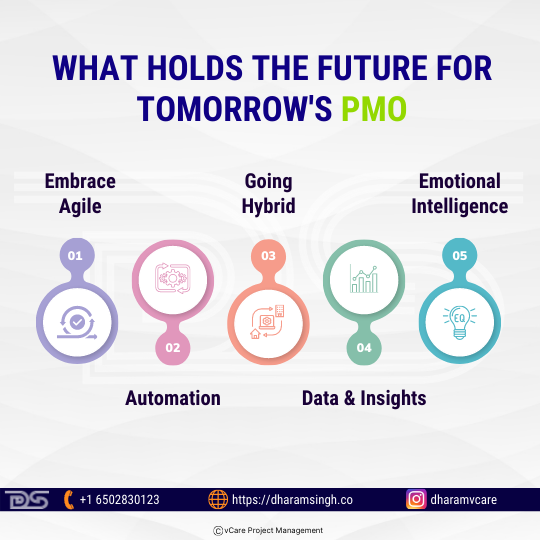
What holds the future for Tomorrow’s PMO
PMO will hold the forte of what matters for the business. They will own the projects and drive results for the organization. In a world where business and IT are more intertwined, the Role of PMO will act as a glue that bonds them together well. PMO will no longer be a support function but will be infused into the business as a core strategy. They will demand that X is needed for Y to be achieved, and this will drive the business objectives and momentum.
Embrace Agile: It has been more than 20+ years since the agile manifesto was released, and the PMO will be more flexible than ever. Organizations are adopting Agile Pods (Product Oriented Delivery) which are a group of small self-organized people with varied skills focused on bringing on the results in development. PMOs will work through this pod and manage the resource pool dynamically based on the project demands with cross-functional awareness. Adopting agile methods by PMOs will result in faster delivery timelines and a more collaborative approach to satisfy stakeholders from a 360-degree perspective. This kind of approach will create a more adaptable PMO function that can be reused and adapted as the PMO function expands its horizons.
Automation: Leverage automation to enhance the speed of delivery. PMOs must identify opportunities for improvement on routine tasks that can be automated. Focus on automating report generation and automation. We need to use the means of notification based on the criticality of the issues to the respective stakeholders. Leverage AI and bots to respond to common queries on the PMO through manual means at enterprise levels. Leveraging automation and AI would help free up critical time for the PMO office to focus on the organization’s strategic goals, act as an enabler to focus on project blockers, and help mobilize resources to resolve bottlenecks in critical paths.
Going Hybrid: By leveraging the tools which can help collaborate better, all the project-related tasks, resources, and people are brought to one place. Teams with varied skills, styles, and different views work together irrespective of place to bring more stability, engagement, and efficiency. Flexible work schedules would also help attract talent and broaden the options which are boundaryless. This freedom also allows the PMO to explore all the options in engaging or onboarding resources required for bringing good results.
Data & Insights: The ability to gain insights from the data is the trend as the data volume is moving from GB to TB. There are heterogeneous data sources beyond organizations that are more external and are to be analyzed through API and SDKs with other systems for meaningful inferences. Data getting converted information and the PMOs responsibility to forecast and identify risks with the knowledge gained through insights will be crucial for the organization. Information insights have to be obtained in less time to act upon it. Integration of communication channels and making it more flexible on push/pull gives the right balance to act upon the information.
Emotional Intelligence: Projects are made of people. People are dealt with emotions daily. Beyond cost, quality and scope, the project managers have to manage the people’s vital resources in the project with care in the times of higher attrition. Striking balance between the millennials and their expectations is crucial, which can be managed through appropriate emotional intelligence management. Managing it would result in handling pressure, making better decisions, strong relationships, and positively impacting the work environment.
Although stakeholders are generally satisfied with current PMO performance, there is a sense that PMOs will need to do the following in the coming years:
- Increase their role in strategic elements of a program, transformation, or organization while decreasing the time spent on transactional processing.
- Increase your tooling and automation, which will allow you to de-scale and facilitate remote working in the “new normal.”
- Organize themselves to quickly “spin up” to support transformations and change the PMO approach as needed.
- Play a bigger role in fusing the “traditional” PMO approach with Agile working methods.
- When establishing and changing the PMO approach, prioritize stakeholder engagement, especially for the larger stakeholder community, and plan specific change activities.
Evolution of PMO – Today & Tomorrow
The PMO’s role might keep changing, but the concept of bridging the gap between today and future PMOs is learning from failures.
- PMOs lose sight of the strategy and become mired in tactical or administrative tasks.
- PMOs maintain a project portfolio that contains gaps, overlaps, and other waste.
- PMOs add processes rather than simplifying or eliminating them.
- PMOs believe that tools will solve all of their problems – or that the flashiest tools will solve all of their problems.
- Even when they provide value, PMOs fail to communicate it.
- PMOs waste too much time on meaningless – or bad – reporting.
- PMOs do not track what is essential or hold people accountable.
- PMOs do not optimize or provide transparency into resource utilization.
- PMOs behave more like police officers than aid workers.
- PMOs either cannot find their place in an agile world or resist it.
As per PMI research, more than 55 percent of PMO directors say the charter for their PMO has changed in the past five years as the impact of technology on PMO is dynamic. The PMO, as part of the organization, is affected by this disruption without exception.
Some examples of the technology used in PMO and its impacts:
- Cloud – 66%
- Digitalization – 54%
- Artificial Intelligence (AI) – 25%
- Internet of Things (IoT) – 24%
- Blockchain – 11%
Conclusion
Transformational PMO needs to learn quickly and must embrace digital disruption. The experts in the domain of PMO have to implement their tools wisely. A new generation of PMOs will be strategic enablers, bridging the gap between a company’s vision and how that vision comes to life. Future PMOs could be virtual or Hybrid. If you are setting up your PMO today, consider all the technical and digital options available on the cloud to use it best. These options would help manage Strategic, Tactical, and operational levels. Include that in your budget. This budgeting would also bring on Collaboration and Transparency. The high use of PPM-Portfolio/Program Management Tools would be crucial for larger organizations. PMO is no more an organization of assigning tasks and monitoring them; it’s well beyond boundaries.
Feel free to check out my discussion on this topic with Thomas Walenta in YouTube.
You can subscribe and follow my podcasts and interviews with Project Management Experts on YouTube at https://bit.ly/2NDY8wd
You can subscribe to vCare Project Management YouTube Channel to catch future videos of our certification Q&A series and student success stories using the link https://bit.ly/2YF0wJl
For any questions related to Project Management career, training, and certifications, you can book an obligation free 15 minutes session with me by visiting talktodharam.com
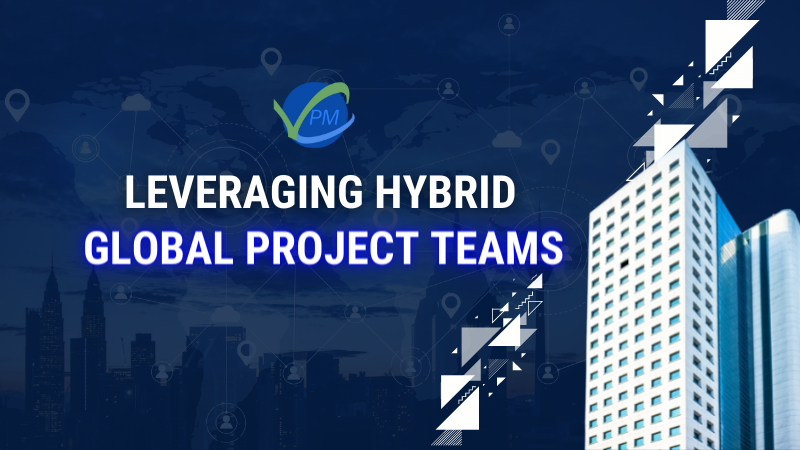
by DharamCW | Jul 8, 2022 | General
COVID-19 has greatly accelerated the digital transformation across various industries. Hybrid work has become the new norm, visibly seen in the hybrid cloud adoption of up to 20% and a decrease in utilization of on-premises workload by 13%. These statistics indicate that more companies trust cloud-based deployments, and organizations are inclined towards such trends.
Global hybrid project teams
Hybrid global teams adopt hybrid work. This adoption could be more defined as a flexible model with a blend of in-office, remote and on-the-go work approaches. The key focus of this model is to provide more autonomy for employees to be productive wherever they work. Such a move would enable team members to migrate between choices of various locations depending on the work which needs to get done.
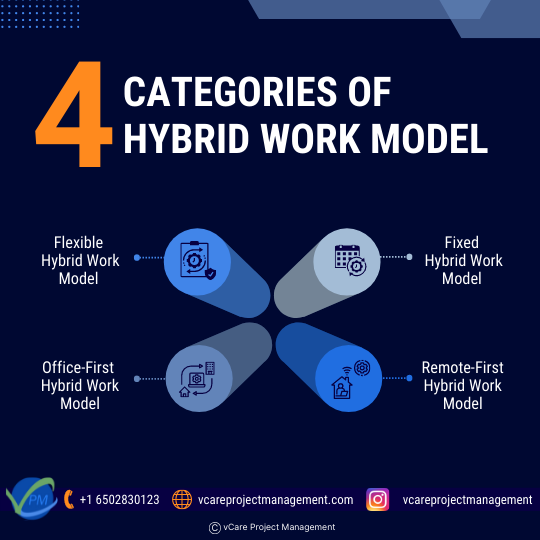
4 categories of hybrid work model
These are typically categorized into
a) Flexible hybrid work model – Where employees choose their work location and hours. This model would provide more autonomy and expands the talent pool and diverse thinking, yet it would be difficult for employers to plan capacity.
b) Fixed Hybrid work model – Employees would plan their days and workplace well ahead, or work would be in the office on predetermined days. Such planning might allow in-person collaboration and increases the opportunity for better planning yet would minimize the lack of choice for individuals.
c) Office-first hybrid work model – In this model, a specified number of days are to be worked in the office, and for the rest of the days, they can choose to work remotely. This model gives flexibility to individual choices and maintains company culture and community, yet it would be challenging to understand and manage individual work plans.
d) Remote-First hybrid work model – In this model, the employees are asked to make remote work a priority and occasionally visit the office for training and collaboration. This model would minimize office space and help reduce costs for employers, though employees might feel isolated.
Typical characteristics of Hybrid Team(s):
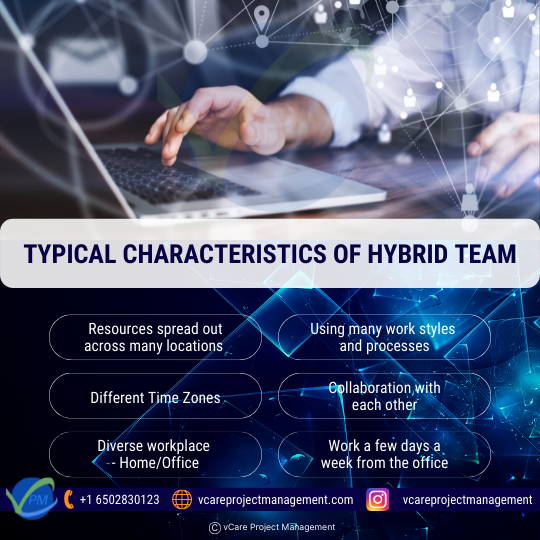
Typical characteristics of Hybrid Team
– Resources spread out across many locations
– Using many work styles and processes
– Different Time Zones
– Collaboration with each other
– Diverse workplace – Home/Office
– Work a few days a week from the office
Current Scenario
- As per the work index trend 2022 report, already, hybrid work is up to seven points year-over-year (to 38%), and 53% of people are likely to consider transitioning to a hybrid workplace in the year ahead
- As per the report from “globalnewswire. in”, nearly 90% of project teams work in multiple locations, with 48% in multiple locations in one country and 39% in many countries.
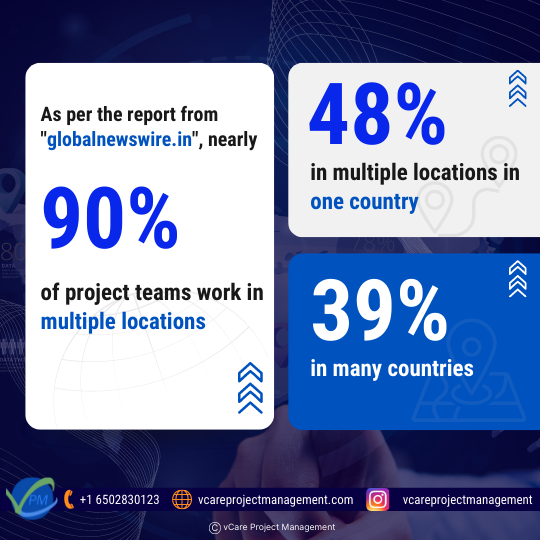
Current Scenario
A Global Survey of Executives, Employee Experience Experts, and Knowledge Workers, Dimensional Research | October 2020
The above paper examines research that sought to understand the impact of COVID-19 on the workplace, the current state of remote workers, their concerns about returning to the office, and the role technology can play in assisting businesses in their transition to the hybrid workplace.
Working from Home, the New Normal
- 58% will work eight or more days each month from home (post-COVID)
- 98% of meetings will include participants joining from home (post-COVID)
- 98% share frustrations with video meetings when working from home
Employees Uncomfortable Returning to the Office
- 97% of employees want changes to make them feel safer at work
- 99% of companies are planning sweeping changes to the workplace as a result of COVID-19
- 94% of companies say the technology would benefit them by providing a safer work environment
Hybrid Work Environment
- 77% of larger organizations will increase work flexibility while 53% will shrink office sizes
- 89% of employees cite frustrations with in-office experiences
- 96% indicate they need intelligent workplace technology to improve work environments
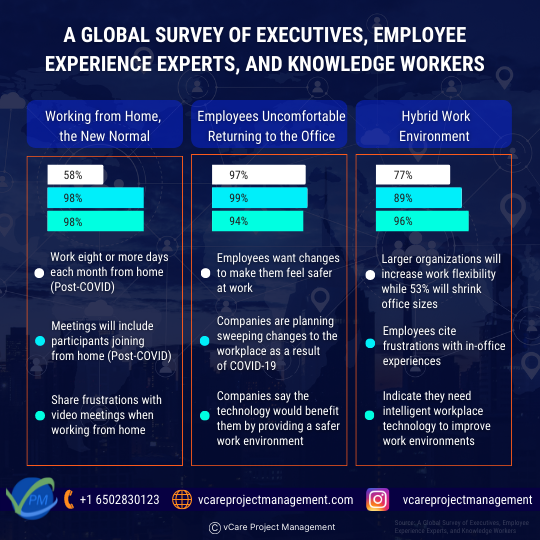
A Global Survey of Executives, Employee Experience Experts, and Knowledge Workers
Leveraging benefits of Hybrid Global Teams
Offices are changing. We are seeing trends of safety/wellness right from the security gate. We are getting into the norm of seating arrangements based on social distancing, touchless elevators, improved ventilation, etc. While we see this increasing trend in hybrid global project teams, we will discuss the benefits and further aspects of the same in detail:
Flexibility and Autonomy
For some, the flexibility mantra is “get connected and get work done from anywhere.” The hybrid scenario is, “why don’t you get to the office and get some work done.” In reality, based on research, flexibility goes beyond that. The members of global hybrid teams are looking for autonomy where they decide when to work from home and when to work from the office. Global project managers understand these expectations and start engaging in models with HR and Administration teams to enable the same. When there is an insistence on specific days or mandates for a specific work location, teams feel stressed, and it becomes an intrinsic threat. Yet, people desire to have in-person connections when they want to work on engagements where there is ambiguity and a need for a physical product or engineering-related aspects. So there are always scenarios that the project or program manager needs to understand and enable an appropriate inclusive approach.
Ease of Collaboration
When there is a clear need to provide flexibility and autonomy to the hybrid teams, it would be fostered and managed through good means of communication. The collaboration tools enable seamless communication with clearly laid guidelines. The guidelines would help set common ground among peers, reporting managers, and clients without going overboard. The tools for collaboration must be standardized and consistent examples of using one tool across the organization must be adhered to.
Inclusive hybrid meetings should occur with onsite/off-site teams across multiple GEOs without opting out. Setting expectations about response times and which communication tools team members should use is critical in reaping the benefits of collaboration. Identify multiple communication channels, including text messaging, video conferencing, or voice calls. Leverage them appropriately, based on the guidelines set. Provide necessary training to enable the team members to determine when to use what. Evaluate needs for increased adoption of tools like JIRA, Monday.com, and Asana for tracking project activities with absolute milestones and timelines. Establish remote-based activities to ensure retaining cultural aspects of the organization beyond work.
Operational Cost
A global talent pool through remote working would help cut operational costs significantly. Fewer people in the workplace means you have reduced unused space, and obviously, you will get financial benefits when you move to a smaller office or use it for different purposes. This move might, in turn, reduce rentals, energy costs, media usage costs, etc. It might also foster creativity in creating a dynamic workplace resulting in better space utilization, further saving costs in terms of fuel for the employees or travel for commuting to the office. Employees are open to selecting the place of liking with less operational cost to work, creating cost-effective and better hybrid teams.
It’s also imperative for the HR, administration, and IT Infrastructure team to enable the hybrid work environment by providing support on a reliable internet connection, providing access to collaboration tools, enhanced and responsive help desk, collaboration on files, and minimizing the needs for multiple access credentials for different applications by enabling single sign-on, etc.,
Meeting Team member’s needs
Hybrid work models minimize the absences/leave from work for trivial needs or minor issues at home. In case of minor/negligible health issues, employees continue to work from home without affecting the office environment, allowing them to heal themselves and continue performing with the tiniest impact on their health. It allows situations like a single mother or father to take care of a sick kid and provides flexibility to attain a good work-life balance. This kind of work model provides a sense of safety and belonging to the employer, not to repeat that moving out of this option might pose a threat regarding retention issues to HR.
Tracking projects in Hybrid global project teams:
As per the new Global Trends in Project Management 2022 report, there are a few challenges in managing projects in today’s hybrid world.

Challenges in managing projects in today’s hybrid world
- Poor cross-team collaboration
The hybrid team is highly likely to split into many groups like the “us vs. them” mentality. So the relationships between co-workers turn too formal, and many traditional opportunities for relationship-building between team members may fail. In addition, it’s more difficult to maintain close friendships with poor cross-team collaboration in hybrid work culture.
- Difficulty working in a remote environment
Working from various locations, time zones, and cultural differences may affect the team’s coordination. These significant factors can create substantial challenges among the team in a remote environment, including managing projects, remote collaboration, task tracking, and productivity.
- Lack of visibility
Information sharing in hybrid teams is frequently uneven and may create miscommunication among the team. This aspect may lead to a lack of visibility, and disparity creates an irrelevant information hierarchy among team members. Hybrid teams should be aware of the problem among the team and set ground rules to ensure that the issues are sorted out consistently.
- Time-consuming reporting
The hybrid work culture will likely affect the team’s productivity. According to many studies, remote workers work only a few hours daily and spend their free time on social media. This phenomenon means that, despite the best efforts, hybrid teams certainly don’t impose the best time in management practices.
- Outdated processes
Outdated processes are more than an annoyance that impedes a company’s day-to-day operations. They become ingrained in your company’s identity, creating impassable trenches between departments, causing team dissatisfaction and inefficiency, and jeopardizing overall success.
- Ineffective scheduling
Poor project planning and scope creep are the leading causes of hybrid team failure. Project managers either lack an overview of all tasks and milestones or struggle during unanticipated schedule changes that affect overall delivery timelines.
- Difficulty in incorporating agile processes and plans
It will be challenging to create a hybrid work culture that blends Agile and traditional plan-driven project management principles and practices in the right proportions to fit a given situation. But doing so takes a lot of skill and understanding how to balance the two can be crucial to success.
- Outdated software
Hybrid workers also spend an hour or more per week dealing with technical issues, saying they aren’t well-supported when troubleshooting problems. In addition, it may lead to a loss of productivity. Forcing employees to use outdated technology and providing insufficient support may result in an organizational brain drain.
How the project manager should equip to handle these challenges?
The project manager has to identify areas where there is a need for physical presence. Explain the dynamics to respective peer members on the need for certain individuals to be in the office for work. For example, the projects that need physical access to the Lab, teams working on embedded products available only in office locations due to client restrictions, etc., a right mix has to be identified, such as fully remote, full onsite, or a combination of both. Project managers should also focus on the schedules considering the global teams involved.
These kinds of challenges mentioned above lead to miscommunication or misinterpretations. Clarity needs to be brought in between the project manager and team members in the hybrid global teams’ perspective with the help of well-established communication guidelines. Clarity will avoid confusion and promote efficiency. Project managers need to be trained on hybrid scenarios and tools essential to managing better. They need to get exposure to project management tools, collaboration tools, and IT Infrastructure setup such as VPN, remote access, etc. concerning collaboration tools or using tools for virtual meetings – aspects like Polls, Hand raise, and Q & A options to collaborate better.
Maximize the opportunity of meeting at a physical workplace to clear the air on certain issues and make the best use of time to increase clarity on project goals and open issues. Establishing feedback loops while implementing the hybrid global project models is important. The project managers need to ask for feedback from the team. Leveraging surveys and getting additional details on feedback and implementation would be very handy.
With hybrid work, whether employees’ desires have changed?
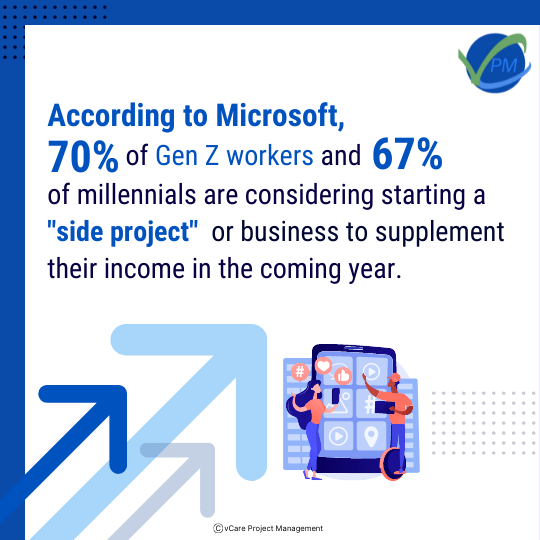
According to Microsoft
“Perks like free food and a corner office are no longer what people value most,” Microsoft says.
Instead, a positive culture (chosen by 46 percent of survey respondents), mental health and well-being benefits (42 percent), and a sense of purpose or meaning are the top things workers want from an employer, aside from a good salary (40 percent). Flexible hours are also highly regarded.
Creativity is becoming increasingly important, and more employees seek to design their jobs around it. According to Microsoft, 70% of Gen Z workers and 67% of millennials are considering starting a “side project” or business to supplement their income in the coming year.
Summary
Hybrid global project teams present challenges and opportunities for the project managers, demanding prudent strategy and pragmatic planning. It is time for project managers to exhibit leadership skills by understanding hybrid models deeper. After all, projects are run by people, and the team needs to stay on course to deliver value to all the stakeholders.
Feel free to check out my discussion on this topic with Thomas Walenta in YouTube
You can subscribe and follow my podcasts and interviews with Project Management Experts on YouTube at https://bit.ly/2NDY8wd
You can subscribe to vCare Project Management YouTube Channel to catch future videos of our certification Q&A series and student success stories using the link https://bit.ly/2YF0wJl
For any questions related to Project Management career, training, and certifications, you can book an obligation free 15 minutes session with me by visiting talktodharam.com
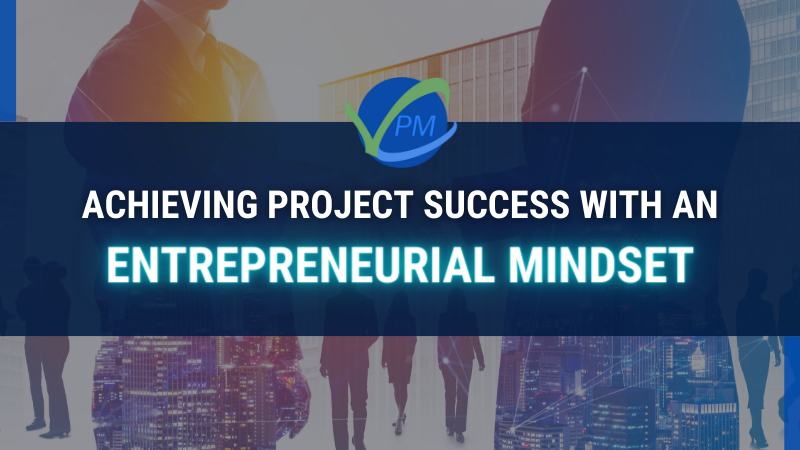
by DharamCW | Jun 12, 2022 | General
Two relevant quotes which quickly strike our minds when we think about the Entrepreneurial mindset are:
“Building a business is not rocket science; it’s about having a great idea and seeing it through with integrity.” Richard Branson
“At 211 degrees, water is hot. At 212 degrees, it boils. And with boiling water comes steam. And with steam, you can power a train.” S.L. Parker
Ideally, a project’s success is based on the critical success factors identified during the initial stages of the project, which would fall in various areas such as Process, Product, Project Management, Business, and Strategic. When the project can make a positive and long-standing impact on business value, a culture deeply imbibes into people’s minds. It creates an undeniable mark in the overall scheme of things.
Benefits and stakeholders’ satisfaction are the key factors that measure a project’s success. It’s also defined by the level of efficiency the project creates based on the set project objectives. Project success is based on the project success criteria and outcome. Typically, these criteria fall as Meeting the Scope identified, Deadlines and Milestones on time, Within the given budget, excellent satisfaction to the stakeholders, both internal and external, and with specified quality criteria.
Essentially, we all know that various tenets of project management contribute to success. Here, we will discuss how the entrepreneurial mindset would impact project success. Entrepreneurs have some unique characteristics such as being adaptive, decisive, risk-tolerant, persistent, able to handle failure, experimenting, building teams, etc.,
Mindset
One must believe that we can be malleable to unlock our growth as project managers or portfolio managers by transforming into an entrepreneurial mindset. We need to understand what mindset is, then understand the characteristics of an entrepreneurial mindset and how we can embark on that transformation journey from where we are to bring on project success in our project management career.
Mindset is an essential set of beliefs that provides a shape in terms of the view one has on the world and themselves. It influences how we think, act, feel and respond to a given situation. Typically, mindset falls into two categories as introduced by Carol S. Dweck, which we are all aware of: they are a) Fixed Mindset and b) Growth Mindset.
An entrepreneurial mindset is a growth mindset. Intelligence cannot be developed with a fixed mindset. A growth mindset is all about the belief that intelligence can be developed through personal effort, good learning strategies, and lots of mentoring and support from others. As introduced by Heider, the interpersonal process equation is a product of Ability, Motivation, and Environment.
An entrepreneurial mindset is a set of skills that allows people to recognize and capitalize on opportunities, overcome and learn from setbacks, and succeed amidst challenging backdrops. An entrepreneurial mentality is a method of thinking that helps achieve your business objectives. Entrepreneurs who learn from their mistakes and failures have a better chance of future success.
Entrepreneurs boost the economy by creating jobs and developing new products and services that benefit the entire world. A great entrepreneur must be able to think outside the box and come up with out-of-this-world ideas.
Entrepreneurial mindset and project management
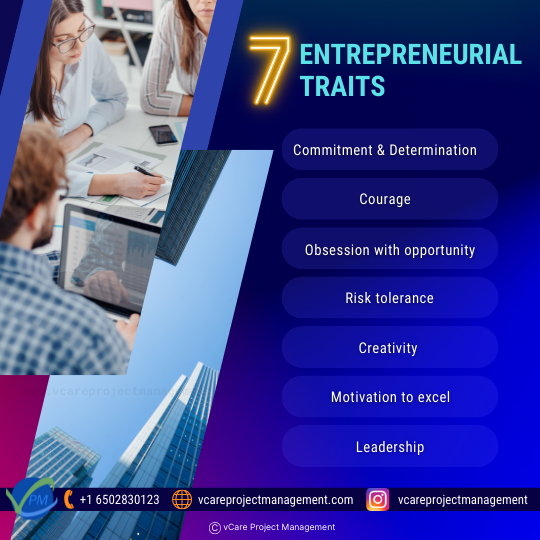
7 Entrepreneurial Traits
Though there is a common belief that entrepreneurship cannot be taught, and they should be born, studies have proven that it’s a myth. Typically, entrepreneurs search, seize and exploit the opportunities while mitigating them through engagement, courage, and perseverance. The following are the entrepreneurial traits that are generally encompassed in an entrepreneur:
- Commitment and Determination
- Courage
- Obsession with opportunity
- Risk tolerance
- Creativity
- Motivation to excel
- Leadership
An entrepreneurial mindset fosters more value for projects. Your project teams are encouraged to solve business problems and develop creative and innovative ideas. When a leader allows the teams to be creative and innovative, they will be more productive and engaged in the project.
The journal “People’s confidence in innovation” indicates that confidence in innovation is a component of the entrepreneurial mindset. In several ways, confidence in innovation can be considered part of the entrepreneurial mindset.
- First, entrepreneurs have more confidence in innovation than non-entrepreneurs.
- Second, confidence in innovation is positively related to other aspects of the entrepreneurial mindset, most notably self-efficacy, opportunity alertness, risk propensity, and role-modelling.
- Third, according to (Nochian and Schtt’s 2012) study, entrepreneurs are not like other people. Instead, their network appears to be the source of their confidence. In the same way, highly networked owners or managers are highly confident in innovation.
- Fourth, their innovativeness appears to be a result of their confidence. The more confident entrepreneurs are, the more innovative they are.
Entrepreneurial mindset and Project success
Commitment & Determination
Commitment and Determination would encompass Decisiveness, Tenacity, Discipline, persistence in solving problems, willingness to sacrifice, and being completely immersed in the mission. In the context of project management, each of these characteristics would contribute to the project’s success. For example, it is being decisive in terms of critical path challenges and exhibiting tenacity for unblocking issues without giving excuses for the need of the project and solving problems. Being committed requires a lot of sacrifice and discipline to bring on consistency. When being disciplined, it would require more like a parenting skill which would always course correct in the larger interest of the project, though seen to be tough externally. Discipline is brought about by establishing an unalterable set of rules and regulations to follow for the project’s success.
Courage
The definition of courage is “mental or moral strength to venture, persevere, and withstand danger, fear, or difficulty” (Mish, 1994, 266). Courage could be implemented with excellent values through moral strength, fearless experimentation, unafraid of conflicts, no fear of failure, and intense curiosity amidst facing risk. A courageous project manager would tackle the controversies and conflicts in the project early. A fearless project manager could put his job on the line in the pursuit of doing The Right Thing for the project. Often, the project manager would not have the necessary support and face active resistance, which needs to be managed with resolve to move beyond personal discomfort through intense curiosity.
Obsession about opportunity
An entrepreneur constantly looks for opportunities for improvement. Similarly, project managers consistently look for opportunities for improvement daily by observing day-to-day activities seeking to do more, do better, and do differently. Obsession with opportunity would be recurring, which would preoccupy or intrude on the project manager’s mind. This obsession would naturally shape the opportunity and help focus on project needs. Obsession with opportunities drives business value through the project.
Risk Tolerance
Good project managers would tolerate risk while being calculated risk-taker and risk sharers, thereby minimizing the risks. He would exhibit the characteristic of an entrepreneur by showing the ability to manage stress/conflict and ambiguity. Especially when the project has larger integrations and frequent changes would increase the ambiguity and uncertainty proportionally. Generally, the unknowns which are in the project would cause ambiguity. The ability to understand those would help identify the risks involved. PMBOK defines these areas in terms of Risk tolerance, Risk appetite, and risk threshold. It guides the management of these effectively through appropriate processes involving planning, controlling, and appropriate level of communication.
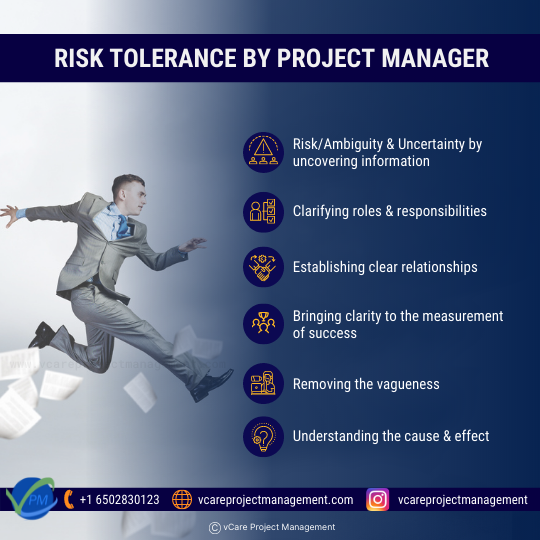
Risk Tolerance
Project managers should learn how to maneuver ambiguity. As ambiguity would be sinusoidal over time, it would arise and settle. The project manager must manage risk/ambiguity and uncertainty by uncovering information, clarifying roles and responsibilities, establishing clear relationships, bringing clarity to the measurement of success, removing the vagueness, and understanding the cause and effect.
Creativity
So what is creativity? In “The Social Psychology of Creativity,” Amabile (1983) defines creativity as,
“A product or response will be judged as creative to the extent that (a) it is both a novel and appropriate, useful, correct or valuable response to the task at hand, and (b) the task is heuristic rather than algorithmic” (p. 33).
Creativity can be multiple things. It would always push your limits by being open-minded, lateral thinking, ability to conceptualize by going into details, and ability to adapt. Creativity can be unleashed in project setup during Brainstorming sessions, Root Cause Analysis, Force field analysis, Affinity Diagrams, SWOT Analysis, etc. Creativity can be fostered further by open communication and providing an environment for the resources involved. As a project manager, one needs to remove the mental blocks like “Always looking for the right answer,” “avoiding ambiguity,” “I’m not creative,” “Always looking for concrete answers,” and “That’s not my area,” etc., Encourage creative aspects through “Why not like that,” “Let’s explore more,” “what value it would bring in,” etc.,
Motivation to excel
There is a popular phrase. Projects don’t succeed; people do. Typically the project’s success is always attributed to the people. People tend to have a goal and result orientation and need a self-imposed drive to achieve the results. Typically entrepreneurs keep motivating themselves and others around them despite all odds. People involved in projects need interpersonal support, understanding of weaknesses, and guidance to overcome them. Essentially aspects like having a sense of humor and perspective on the value they are adding to the project would motivate them to do better. The project manager’s responsibility is to understand individuals and adopt appropriate motivations strategy based on their needs, desires, and goals. They reward the team and its members creatively by recognizing their strengths. Make the project goals and success factors visible to the entire team. They are clarifying how the performance will be validated as an exact measure.
Leadership
Leadership is one of the essential traits entrepreneurs have. They would be self-starters and have a strong internal locus of control. Locus of control is the degree to which people believe that they, as opposed to external forces (beyond their influence), have control over the outcome of events in their lives. The concept was developed by Julian B. Rotter in 1954 and has since become an aspect of personality psychology. Project managers with an Internal Locus of Control believe that every event in their life derives from factors under their control. These individuals tend to blame or praise themselves for whatever success or failure they experiment in life. They would have enormous patience, integrity, and reliability. They would build teams and more leaders. Key attributes of communicating with a project management mindset include empathy, clarity, authenticity, and flexibility.
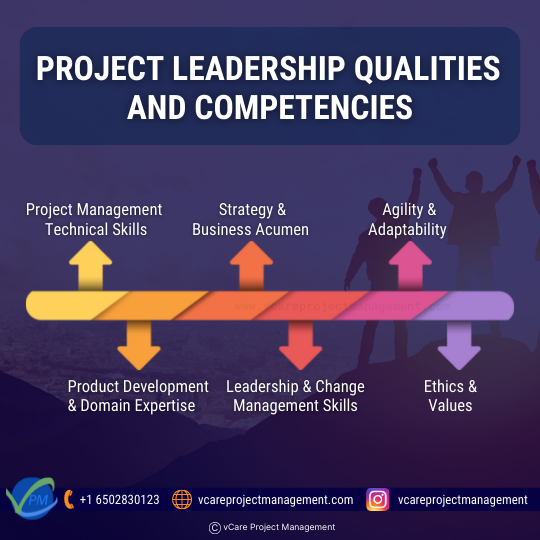
Project leadership qualities and competencies
Successful projects come as an outcome of a well-coordinated team effort. Project managers as leaders know their team very well.
The entrepreneurial mindset’s key aspects of a project’s success
Being confident and open-minded is crucial for a project professional with an entrepreneurial mindset. It’s about being self-assured, optimistic, and never afraid to take risks. Every day, if you have an entrepreneurial mindset, you will be ready to take action to achieve your goals and acquire project success.
While some scholars have examined aspects of the entrepreneurial mindset and provided general insights into its attributes, qualities, and operations, the question remains how people tap into it.
- The cognitive aspect—how do entrepreneurs use mental models to think?
- The behavioral aspect—how do entrepreneurs engage or act for opportunities?
- The emotional aspects—what do entrepreneurs feel in entrepreneurship?
Project leadership qualities and competencies
When the project requires success, both project managers and project sponsors should take up the role of a project leader by demonstrating leadership talents, competencies, and entrepreneurial mindsets. The following are the most significant features of effective project management:
- Project management technical skills
- Product development and domain expertise
- Strategy and business acumen
- Leadership and change management skills
- Agility and adaptability
- Ethics and values
Conclusion
The entrepreneurial mindset is an important factor leading to project success. Many leading authors agree with this point of view and are researching to substantiate this grounded theory. This endeavor to bring out the factors associated with the project manager’s leadership style profoundly impacts project success.
Feel free to check out my discussion on this topic with Thomas Walenta in YouTube
You can subscribe and follow my podcasts and interviews with Project Management Experts on YouTube at https://bit.ly/2NDY8wd
You can subscribe to vCare Project Management YouTube Channel to catch future videos of our certification Q&A series and student success stories using the link https://bit.ly/2YF0wJl
For any questions related to Project Management career, training, and certifications, you can book an obligation free 15 minutes session with me by visiting talktodharam.com










































Recent Comments